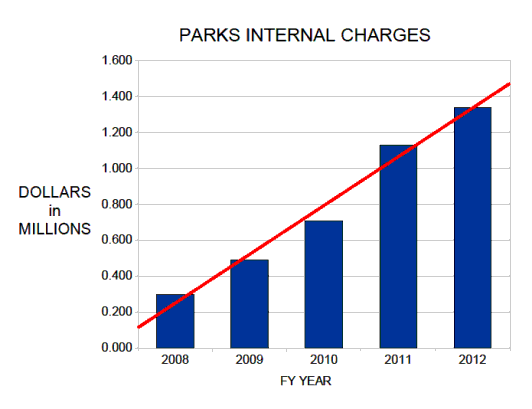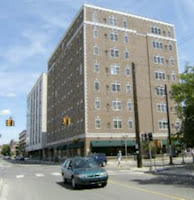Background
The Ann Arbor Parks are funded from two sources. One is the city general fund which obtains money from the general city property taxes. The other is from special additional taxes that the citizens have agreed to pay, the Parks Millage.
In 2006 the Ann Arbor City Council proposed a new Parks Millage of 1.1 mills. This millage replaced two smaller millages that expired that year. The new tax was expected to generate slightly less than $5 million annually. This was approximately $1 million more than the millages it replaced. The increased tax was approved by the voters in November of 2006.
There was substantial popular concern that approving the additional millage would result in a shift in the Parks funding from the general fund to the millage rather than increasing the actual amount available for maintenance and improvement of the parks. To reduce this concern and encourage the voters to pass the increased tax, Council passed two resolutions, promising that if the 2006 park millage was approved the funding for parks from the general fund would increase or decrease by the same proportion as the general fund increased or decreased.
The first resolution passed in August 2006 stated that the funds for Police and Fire (Safety Services) were to be excluded from the calculation of the increase or decrease of the general fund. This was amended in October to remove the exclusion of Safety Services from the calculation.
Both resolutions included a statement that the parks millage money would not pay municipal service fees. This was to avoid the transfer of fees from the millage to the general fund by a "back door" service charge.
The purpose of this report is to test if the city is following Council's 2006 promise to the citizens.
Data
The data used in this analysis are from the cities and the city's proposed budgets. The data for the years 2007 through 2010 are from the audited financial reports . The data for the years 2011 and 2012 are from the proposed budgets.
GENERAL FUND
First let's look at the general fund

The red line is a linear regression line fitted to the data. This is a common method to predict trends and is often called a trend line. The trend is clearly flat.
The large increase in 2009 was the cost of the police early retirement. If the data from 2009 did not include the early retirement, the result would still be the same, or at most any trend would be very minor.
It should be noted that when Council member Taylor and others refer to the multimillion dollar “short fall” of the current budget this is not so much a short fall from past budgets as it is a short fall from the additional amount they wish to spend or have already spent.
PARKS
Now consider the contribution from the General Fund to the Parks.
Here is that chart
The additional taxes were first collected in FY 2008. The council resolution promised that Parks funding from the general found would not decrease if the voters approved the additional millage. Yet in every year since 2007 the funding has been reduced. The average decrease has been 14%. The trend is that decrease is increasing each subsequent year. The rate of decline is $290,000/year.
The parks appropriation have not followed the council resolution, as ammended in October 2008.
At the April meeting of the Parks Advisory Commission meeting Colin Smith stated that Parks staff relied on a document, “The Policies for Administration of the November 7, 2006 Charter Amendment” as their guide for following the Council resolution.
Council member Mike Anglin requested a copy of this document. The pdf file he received is
here.
It is note worthy that the policy park staff believe they should follow is not the final amended resolution passes by Council. Their policy is based on the August resolution. Even so it is interesting to test if the park allocations agree with their policy statement.
SAFETY SERVICES
Lets look at the safety Service Funds next. Here is the chart of just the police and fire budget; that is the safety services.

The trend in the Safety Service fund dollars, including the budgeted 2011 and 2012 is flat. That is, there isn't any apparent increase or decrease. Again the bulge in 2009 is cause by the additional cost for the early retirement. Without this transfer the trend line would probably have a very slight positive slope.
GENERAL FUND minus SAFETY SERVICES
Since the trend of the general fund is flat, and the trend of the Safety Services is also flat we would expect the trend of the difference to also be flat. Here is a chart of those calculated data.
As expected, the trend line is flat. It is interesting to note that if the budgeted dollars for 2011 and 2012 are excluded, the slope of trend line for the years 2007 through 2010 is positive. The slope is nearly $1 million/year. The confidence in this value would be low because it is based on a small number of data points. Still it is strong indicator that Safety Services funding was cut more in that period than the remaining General Fund.
Again, here is the chart of the allocation of park funds from the general fund.
It is quite clear that the trend in the park allocation from the general fund does not follow either the Council resolution or the inaccurate Park Policy Statement.
MUNICIPAL SERVICE CHARGE
There is also another part of the story. As stated in the second paragraph, the Council resolution at the time the millage was proposed included a statement that the parks millage money would not be used to pay municipal service fees but could include IT and fleet service charges.
The city has not imposed a “municipal service charge” but it has greatly increased the allowable internal charges paid by the millage. It is reasonable that the millage should pay some of these charges. But is unreasonable that they should be increasing at such a rapid rate when services and personnel are decreasing.
Initially in 2006 the charges were about $300,000; they are now budgeted to be over $1.3 million in FY 2012. The administration is doing exactly what Council attempted to prevent in the 2006 resolution. Internal service charges are being used to transfer money from the parks millage to the general fund. Obviously this reduces the millage resources that the citizens agreed to pay for parks improvement and maintenance.
Assertions by Others
The assertion that the city has not kept its promise made to the citizens when the millage was proposed is not new. This allegation was made in 2007 by Council member Robert Johnson, Sierra Club Chairman; Doug Cowherd, and former Parks Advisory Commission chairperson Linda Berauer. Here is a link to the a
video of the Council discussion.
Conclusions
The city has
not kept it promise to the citizens that “if the 2006 park millage is approved by the voters the future funding for parks from the general fund would increase or decrease by the same proportion as the General Fund. It does not matter whether the total general fund is used in the calculation or the General fund excluding Safety Services.
The city has followed the words of the Council resolution prohibiting applying a muncipal service charge to the parks millage funds. It has
not kept the spirit of that promise since the allowable charges have been greatly increased. This further reduces the amount of funds available for park operation and maintenance.
The transfer of funds opposed by Robert Johnson, Doug Cowherd, and Linda Berauer; expressed in the videos from May 2007 have consistently and systematically occurred after the voters approved the millage increase.
Karen Sidney
Glenn Thompson
Karen Sidney is a CPA and attorney and a shareholder in the local CPA firm, Conlan & Sidney PC. Her practice focuses on providing tax advice to small businesses and individuals and litigation support services. For the past several years she has used her investigative accounting skills to dig into city finances.
Glenn Thompson is a licensed professional engineer with a background in matematical statistics and data analysis.






